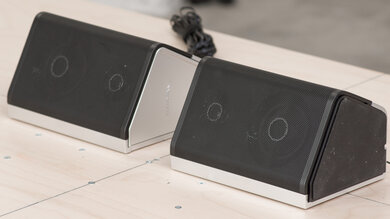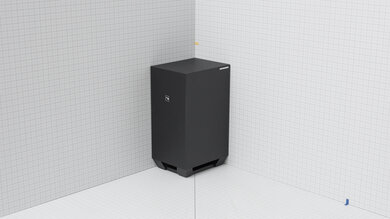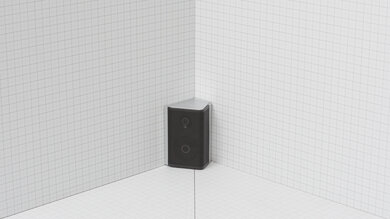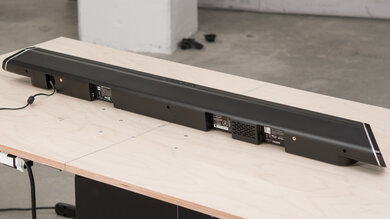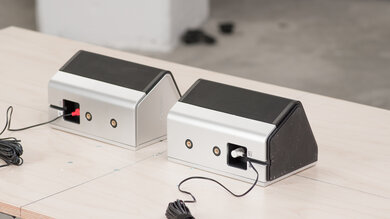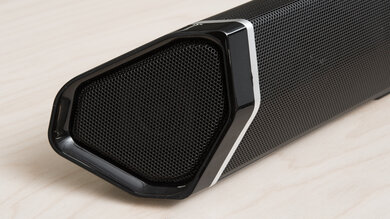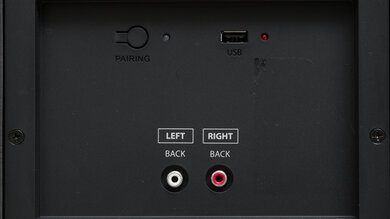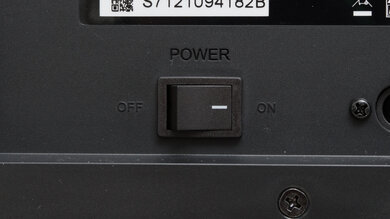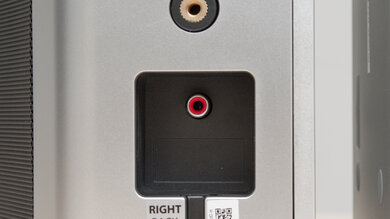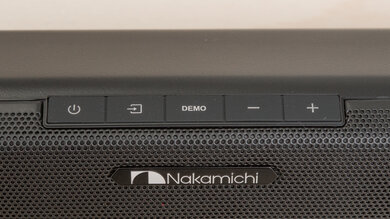The Nakamichi Shockwafe Pro 7.1 SSE is a 7.1.4 setup with many customization features. SSE stands for Spatial Surround Elevation, a unique feature that allows you to choose between three different vertical surround modes based on the distance between the bar, the speakers, and your listening area. Though it has a very bass-heavy sound out-of-the-box, you can customize it to ensure that vocals and lead instruments are clear and present in the mix. It offers immersive surround sound. While its Atmos performance can't beat the more premium models on the market, it's still a fair value.
Our Verdict
The Nakamichi Shockwafe Pro 7.1.4 is good for mixed usage. Though it has a very boomy sound out-of-the-box, it's easy to use its subwoofer level and treble adjustments to customize its sound. Voices in TV shows are clear and accurate, and you feel the rumble in the bass with action-packed movies and bass-heavy music. There are lots of customization features, too. That said, its Atmos performance isn't the best, and the bar struggles to create the illusion of height with sound effects.
-
Subwoofer level adjustment.
-
Gets loud.
-
Great surround sound.
-
Atmos performance isn't very immersive.
The Nakamichi Shockwafe Pro 7.1.4 is very good for dialogue-heavy content like TV shows. It has a discrete center channel that anchors voices to a pinpoint location in the soundstage, and dialogue is reproduced clearly and with detail. Its Clear Voice feature enhances dialogue, too. If you want to stream podcasts to the bar, your options are a bit limited, though, as it only supports Bluetooth connectivity.
-
Clear Voice feature.
-
Bluetooth-compatible.
-
No Wi-Fi, Chromecast, or AirPlay capabilities.
The Nakamichi Shockwafe Pro 7.1.4 is decent for music. While its out-of-the-box sound is quite boomy and bass-heavy, you can use its subwoofer level and treble adjustments to create a more neutral, balanced sound. Vocals and lead instruments are reproduced clearly and with detail, and it offers an extended bass that helps you feel the rumble in bass-heavy genres like EDM. Unfortunately, there isn't a full graphic EQ, so you can't adjust the full range.
-
Subwoofer level adjustment.
-
Gets loud.
-
No graphic EQ.
-
Very boomy sound out-of-the-box.
The Nakamichi Shockwafe Pro 7.1.4 is good for movies. With its deep and rumbling low-bass, you can feel the effects of action-heavy scenes. There are lots of customization features available to enhance its sound, too, including its unique Spatial Surround Elevation (SSE) surround modes. While its performance with surround sound is great, its Atmos performance isn't very impressive.
-
Gets loud.
-
Clear Voice feature.
-
Great surround sound.
-
Atmos performance isn't very immersive.
- 7.6 Mixed Usage
- 7.8 Dialogue/TV Shows
- 7.3 Music
- 7.7 Movies
Changelog
-
Updated Dec 17, 2024:
This review's Style - Bar box was updated to mention the Nakamichi DRAGON.
- Updated Oct 17, 2022: Added market comparison for the Nakamichi Shockwafe Ultra 9.2 eARC to the 'Audio Format Support - ARC' box.
- Updated Oct 03, 2022: Updated the bar mounting results to 'Proprietary' in the 'Back - Bar' and 'Back - Satellites' boxes.
- Updated Feb 16, 2022: Review published.
- Updated Feb 11, 2022: Early access published.
Check Price
Differences Between Sizes And Variants
The Nakamichi Shockwafe Pro 7.1.4 is available in 'Black', and you can see the label for the 7.1.4 model we tested here.
A version of this soundbar was released in 2016 called the Nakamichi Shockwafe Pro 7.1. However, it didn't come with up-firing drivers, and it didn't support Dolby Atmos or DTS:X content. In 2018, the Nakamichi Shockwafe Pro 7.1.4 was released. At the time, it was only advertised to support DTS:X. However, a later firmware update added Dolby Atmos support and SSE. This tested 7.1.4 model was purchased after 2019, so it came with Dolby Atmos and SSE right out of the box.
If you come across another version of this soundbar, let us know in the discussions, and we'll update our review.
Compared To Other Soundbars
The Nakamichi Shockwafe Pro 7.1.4 is a premium 7.1.4 setup with immersive surround sound. Its unique Spatial Surround Elevation feature lets you adjust the bar's performance based on the layout of your listening space, and it supports Dolby Atmos and DTS:X content. Compared to other premium bars on the market, its Atmos performance isn't very immersive, but it does a fair job for its value.
See also our recommendations for the best soundbars, the best Dolby Atmos soundbars, and the best soundbars for movies.
The Samsung HW-Q950A is better than the Nakamichi Shockwafe Pro 7.1 SSE. The Samsung is an 11.1.4 setup with eARC support that offers more sound enhancement features, including room correction and a graphic EQ. It has a more neutral sound out-of-the-box, especially than the bass-heavy Nakamichi. That said, the 7.1.4 Nakamichi is still a good choice, and it even has a better build quality than the Samsung soundbar.
The Nakamichi Shockwafe Ultra 9.2 eARC is quite a unique bar, especially compared to the Nakamichi Shockwafe Pro 7.1 SSE. The Ultra comes with two subwoofers and four satellites, so it's ideal if you want to fill a really large space with sound. With just one subwoofer and two satellites, the Pro 7.1 SSE more closely resembles other bars on the market. That said, unlike the Ultra, it lacks eARC support for formats like DTS:X.
The JBL Bar 9.1 is better than the Nakamichi Shockwafe Pro 7.1 SSE. The JBL is a 5.1.4 setup with a better soundstage and eARC support. It has a more neutral sound out-of-the-box, especially compared to the Nakamichi's boomy, bass-heavy sound. That said, the Nakamichi is still a good choice for mixed usage overall.
The Sonos Arc and the Nakamichi Shockwafe Pro 7.1 SSE are two very different soundbar setups. The Sonos is a premium standalone soundbar that you can upgrade to the Sonos Arc with Sub + One SL Speakers. It has a better soundstag but on its own, can't reproduce as much low-bass as the Nakamichi. Thanks to its satellites, the Nakamichi also has a better surround performance. That said, you can always add on satellites to the Sonos to improve its surround sound.
Depending on your listening habits, you may prefer either the Sony HT-A7000 with Speakers + Bass Module or the Nakamichi Shockwafe Pro 7.1 SSE. The Sony is a better-built setup with eARC support. It has more sound enhancement features like room correction and a more neutral sound out-of-the-box. The Nakamichi gets louder, though, with less compression at max volume. It also has better surround and Atmos performances.
The LG SP11RA is better for most uses than the Nakamichi Shockwafe Pro 7.1 SSE. The LG is a 7.1.4 setup with better Atmos performance and eARC support; it also has more sound enhancement features, including room correction. It has a more neutral sound profile out-of-the-box than the Nakamichi's boomy, bass-heavy sound. You can easily customize the Nakamichi, though. Also, the Nakamichi's surround sound is better.
The Samsung HW-Q900A is better than the Nakamichi Shockwafe Pro 7.1 SSE. The Samsung soundbar supports eARC, and it has more sound enhancement features like room correction and a graphic EQ. Plus, its sound profile is more neutral out-of-the-box, especially compared to the Nakamichi's boomy, bass-heavy sound. You can customize the Nakamichi if you want, though. It's also better-built, with a better surrounds performance thanks to its discrete satellites.
The Nakamichi Shockwafe Pro 7.1 SSE is a pared-down offering compared to the Nakamichi DRAGON. The Shockwafe features a plastic design, in contrast to the DRAGON's metal construction. Though it packs a similarly bass-heavy sound into a much more compact frame, it does fall short of the DRAGON in a few key areas, including default frequency response, center performance, and dynamics. The DRAGON also features HDMI 2.1 with 4k passthrough at 120Hz, and its three HDMI In ports make it a great option for gamers with multiple consoles. That said, the DRAGON's high retail price will deter many.
Test Results
The Nakamichi Shockwafe 7.1.4 has an identical design to the soundbar of the Nakamichi Shockwafe Ultra 9.2Ch. It's mostly plastic, with a metal grille covering the front and the side speakers. It's entirely black, with silver metal accents around the angled edges that house the side-firing drivers. While larger than many popular bars, it's still more compact than the Nakamichi DRAGON.
The subwoofer is mostly wood. It's a bit slimmer than the subwoofers that come with the Nakamichi Shockwafe Ultra 9.2Ch.
There are two satellite speakers, which are mostly plastic. Metal grilles cover the speakers in the front. You have some flexibility when positioning them in your setup. You can lay them down as pictured above, which bounces sound off your ceiling to enhance the vertical effects. You can also stand them up straight, as pictured here. In the manual, the manufacturer recommends that you place the bottom of the speaker at ear level, pointing directly at your sitting area for the best performance.
The subwoofer is also quite large. Compared to the subs that come with the Nakamichi Shockwafe Ultra 9.2Ch, it's a bit thinner, though.
The satellites are identical to those that come with the Nakamichi Shockwafe Ultra 9.2Ch. They're a similar size to other satellites on the market, and you can change their position to better suit your space.
You'll find an input on each satellite for the cable that connects them to the subwoofer. The included cables are pretty long, meaning you can place them far away from the sub without issue. You can also mount them to your wall using the included holes and wall mounting kit. You can see the back of the satellites when they're standing up straight here.
The Nakamichi Shockwafe Pro 7.1 has a great build quality. It's a premium-feeling soundbar setup, with a bar that's mostly made of high-quality plastic and solid metal grilles to help protect the drivers inside. The satellites have a similar build. They're also plastic, with metal grilles protecting the drivers. The subwoofer is mostly wood, but it still feels very sturdy.
The Nakamichi Shockwafe Pro 7.1.4Ch has a satisfactory frequency response. Right out of the box, its subwoofer level - marked on the remote as 'BASS' - is set to '8', and its treble level is set to '5'. The resulting sound profile is quite boomy and bass-heavy, so you feel the thump and punch in your audio. Vocals and lead instruments are still quite clear thanks to the balanced mids, but the treble is veiled and drowned out by the lack of emphasis in the range. If you want to feel the deep rumble in action-packed movies and bass-heavy music, you can plug-and-play. If you prefer a more neutral sound, you can customize it to your liking with the included sound enhancement features.
With calibration, the Nakamichi Pro 7.1's frequency response is very good. With its subwoofer level set to '4' and its treble set to '6', it has a more neutral sound suitable for listening to many different types of audio content. Vocals and lead instruments are clear and detailed, and there's still a little extra punch in the bass to help you feel the energy in high-action movies without drowning out the rest of the range.
Note: The manual says that the bar comes with a bass adjustment feature, but that's not true. Instead, it has a subwoofer level adjustment. The difference? A subwoofer level adjusts the amount of bass reproduced by the subwoofer on its own. Meanwhile, a bass adjustment feature changes the amount of bass reproduced by the subwoofer as well as the bar and the satellites, all at once.
The Nakamichi Shockwafe 7.1 has a good stereo soundstage. The soundstage is perceived to be about as wide as the bar itself. Its focus is really good, too. For example, when you listen to an orchestra, each instrument seems to come from an accurate, pinpoint location in the soundstage.
The Nakamichi Shockwafe 7.1 has a great stereo dynamics performance. It gets loud enough to fill up a large room or a crowded party, and it's more than suitable for listening in a smaller space. Also, when you push the bar to max volume, there isn't a lot of compression. You can crank up the volume without distorting the clarity of your audio.
The Nakamichi 7.1.4 has a very good stereo THD performance. At a normal listening volume, audio reproduction is clear and pure. There's a little more distortion present when you push it to max volume, making frequencies a bit harsh and impure. It's noticeable to audiophiles, but when you watch everyday content, it doesn't stand out.
The Nakamichi 7.1.4 has a very good center channel performance. Its discrete center helps anchor voices to a pinpoint location in the soundstage, resulting in a clearer and more accurate reproduction of dialogue.
The Nakamichi 7.1.4 has a great surrounds performance. It comes with two discrete satellites that help create a more clear and real representation of surround objects in the soundstage. For example, cars moving past in a chase scene seem to come from an accurate, pinpoint location. Placing the satellites in Full Elevation position - or laying them down flat - helps to enhance vertical effects by bouncing sound off your ceiling. The bar's design is pretty unique, too, as its two surround channels built into the bar are also active with surround sound. The result is an immersive experience that makes it seem like the action is happening all around you.
The Nakamichi 7.1.4 has a pretty unique design. When you watch Dolby Atmos content, four up-firing drivers built into the satellites and the bar itself are active, bouncing sound off the ceiling to create the illusion of height. Its two side-firing drivers in the bar are active, too. Despite that, its Atmos performance isn't the most impressive. Its soundstage is a bit wider than when you listen to stereo content, but the action still seems like it's only taking place in front of you. You don't get the feeling of height, even when helicopters fly overhead or you watch a scene in the middle of a noisy jungle. Even with the satellites placed laying down, which is supposed to create more height, it wasn't a very immersive experience.
The Nakamichi 7.1.4 comes with many sound enhancement features. Looking at the remote, you can feel overwhelmed by all the options available, but fortunately, the manual offers a lot of information about each of the settings. You can also find suggested settings to get the most out of your listening experience with Dolby Atmos and DTS:X content.
There are a couple of EQ presets available, including 'Music', 'Movie', and 'Game'. There's also an adjustable night mode feature to reduce sudden changes in loudness, but it's only available with DTS:X and Dolby content. While there's a 'Room' button that changes the sound depending on your room size, it isn't quite like a room correction since there's no microphone being used to analyze your room's acoustics. The bar's Spatial Surround Elevation (SSE) mode lets you choose from three different surround effects based on how far away you are from your TV and the satellites. You can see the manual to determine which mode is best for you.
The Nakamichi Shockwafe Pro 7.1.4 has lots of physical inputs. There are three HDMI In ports and one HDMI Out port. You can plug in an AUX cord to play music off your devices, and you can even play music off a USB drive. Also, there's a Coaxial port for listeners with older TVs.
The Nakamichi Shockwafe Pro 7.1.4 can playback some of the more common audio formats like Dolby Digital and Dolby Atmos, often found on CDs, DVDs, and Blu-rays. However, unlike the Nakamichi Shockwafe Ultra 9.2 eARC, there's no eARC support, which means that the bar doesn't have the bandwidth for higher-quality Dolby TrueHD and DTS-HA Master Audio streams.
The Nakamichi Shockwafe Pro 7.1.4 has fantastic audio format support via HDMI In. It supports common surround sound formats like Dolby Digital, as well as lossless and object-based formats like Dolby Atmos and DTS:X. The bar can receive higher-quality Dolby TrueHD and DTS-HA Master Audio streams with its HDMI In port - it just can't send them out to another device via its HDMI Out port.
Via Optical, this soundbar supports both of the common surround sound formats: Dolby Digital and DTS. You can often find them on Blu-ray discs and streaming platforms.
The Nakamichi Shockwafe Pro 7.1.4 has a great latency performance. Its latency is fairly low, so you don't notice a delay between the audio you hear and the visual on your screen. If you have any issues, there's a Lip Sync feature on the remote that lets you change the timing between audio and video playback. Some apps and TVs compensate for latency differently, though, so your experience can vary.
The Nakamichi Shockwafe 7.1.4 is Bluetooth-compatible, so you can wirelessly stream audio from your mobile devices to play on the bar.
The Nakamichi Shockwafe 7.1.4 supports video passthrough up to 60 Hz, and it also supports Dolby Vision Passthrough. You can connect the bar between two devices, like your PC and your TV, and text on the screen is clear and crisp.
The satellites don't need to be wired to the bar, but you still need to wire them to the subwoofer to get them to work. The included cables are long, so you can still reach the sub even if the speakers are far away. However, it's still not very convenient, especially if you don't want a lot of wires cluttering your space.
Some users have reported connectivity issues with the satellites. Specifically, they found that the sound from the satellites cut in and out. It seems that the issue was resolved with a past firmware update, and there were no issues during the testing process.
The Nakamichi Shockwafe 7.1.4 doesn't have built-in voice assistant capabilities. If you want to control it with your voice, you can purchase a third-party Amazon or Google voice assistant device separately and plug it into the bar.
The Nakamichi Shockwafe 7.1.4 has an Eco mode that automatically puts the bar in standby mode after twenty minutes of inactivity. You can turn it on and off in the setup menu. Also, the bar supports HDMI CEC, meaning you can control its basic functions with your TV remote.
Comments
Nakamichi Shockwafe Pro 7.1 SSE: Main Discussion
Let us know why you want us to review the product here, or encourage others to vote for this product.
Update: This review’s Style - Bar box was updated to mention the Nakamichi DRAGON.




